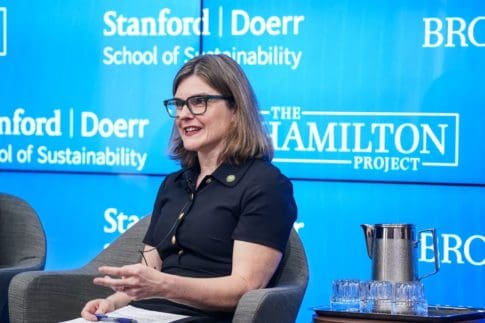On May 22, The Hamilton Project and the Stanford Doerr School of Sustainability hosted an event to discuss the path to a resilient and clean electricity grid. The event coincided with the release of two new policy proposals focused on grid governance and wildfire utility risk. The Hamilton Project also released a facts document on permitting.
Former U.S. Treasury Secretary Robert E. Rubin introduced the first fireside chat with Senator Alex Padilla (D-Calif.) and Evan Halper (The Washington Post). Sen. Padilla shared his optimism for utilities and the grid, noting recent federal investment via the Bipartisan Infrastructure Law as well as progress on rules and regulations. He also suggested that we have the technological capacity to achieve our emissions reductions goals—but that additional investment, including in research and development (R&D), is needed.

Senator Alex Padilla (D-Calif.) speaks at The Hamilton Project and Stanford Doerr’s School of Sustainability event, “Building clean energy: Roadblocks, tradeoffs, and solutions.”
In the first panel discussion, Catherine Wolfram (MIT Sloan School of Management), Shelley Welton (University of Pennsylvania Carey Law School), and Michael Mastrandrea (Stanford Doerr School of Sustainability) shared an overview of their recent policy proposals. Sanjay Patnaik (Brookings) moderated the panel.
Wolfram discussed the potential benefits of carbon pricing, not only in reducing emissions but also in raising revenue without significantly increasing expenditures for the average consumer. She also noted the European Union’s Carbon Border Adjustment Mechanism that went into effect last year, suggesting that the U.S. could drive further progress by adopting a similar policy.
Welton outlined a menu of reforms to address the grid’s governance constraints. Among these, she stated that the primary challenge is that “we’ve largely delegated the planning of the grid to private transmission utilities that plan a grid that works in their best interest.” She commended the new Order No. 1920 from the Federal Energy Regulatory Commission (FERC) but argued that the agency has unexercised authority that it could—and should—use to develop a grid that works in the public interest.
Finally, Mastrandrea discussed a two-step approach to mitigating utility wildfire risk: a federal Utility Wildfire Fund, with access conditioned on compliance with safety standards. This policy proposal draws upon lessons from California‘s approach to managing utility wildfire risk.
The second fireside chat featured FERC Commissioner Allison Clements and Michael Wara (Stanford Doerr School of Sustainability). Clements discussed the challenges facing the grid, including a “massive quantity” of grid interconnection requests and a “strikingly and painfully slow” regulatory process.
“The rules that regulate the grid were designed around a system that no longer exists.”
—FERC Commissioner Allison Clements
Clements then highlighted two significant FERC actions to address these problems: Orders No. 2023 and 1920. She emphasized that these rules are a “starting point” and a “piece of the puzzle,” respectively, agreeing with Welton’s earlier assertion that FERC has the authority to do more.
The event concluded with a panel featuring Suzi Kerr (Environmental Defense Fund), Maria Pope (Portland General Electric), Mark Toney (TURN – The Utility Reform Network), and Wendy Edelberg (The Hamilton Project).
The panelists discussed what they viewed as the key barriers to clean energy progress. Kerr pointed to “incentives and resistance,” stating that we need to “plan well, create processes that better align incentives, and apply the smartest approaches that are available.” Pope highlighted the complex local politics of siting, which can delay—and increase the cost of—efforts to adopt clean energy. Toney argued that consumers will refuse to switch to clean energy if doing so increases their utility bills; he advocated for several reforms, including limits on rate increases.
This is a summary of “Building clean energy infrastructure: Roadblocks, tradeoffs, and solutions.“




